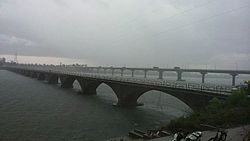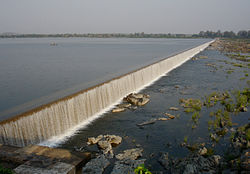This article needs additional citations for verification .(August 2017) |
| Pranahita ప్రాణహిత प्राणहिता | |
|---|---|
 | |
 | |
| Native name | ప్రాణహిత (Telugu) |
| Location | |
| Country | India |
| State | Maharashtra, Telangana |
| Districts | Gadchiroli District, Komaram Bheem Asifabad district |
| City | Sirpur |
| Physical characteristics | |
| Source | Confluence of Wardha and Wainganga |
| • location | Koutala, [1] Telangana, India |
| • coordinates | 19°35′24″N79°47′59″E / 19.59000°N 79.79972°E |
| • elevation | 146 m (479 ft) |
| Mouth | Godavari River |
• location | Kaleshwaram, Telangana |
• coordinates | 18°49′30″N79°54′36″E / 18.82500°N 79.91000°E |
• elevation | 107 m (351 ft) |
| Length | 113 km (70 mi) |
| Basin size | 109,078 km2 (42,115 sq mi) |
| Basin features | |
| Tributaries | |
| • left | Dina River [2] |
| • right | Nagulvagu River, Peddawagu River [3] |
The Pranahita River is the largest tributary of Godavari River covering about 34% [4] of its drainage basin conveying the combined waters of the Penganga River, the Wardha River, and the Wainganga River. By virtue of its extensive network of tributaries, the river drains a large part of Vidarbha region in Maharashtra, as well as the southern slopes of the Satpura Range in southeast Madhya Pradesh. It flows along the border of Gadchiroli district in Maharashtra and Komaram Bheem Asifabad district in Telangana. The Pranahita sub-basin is the seventh largest in India, [5] measuring about 109,078 km2, making it larger than the individual basins of significant rivers such as the Narmada River and Kaveri.[ citation needed ]




